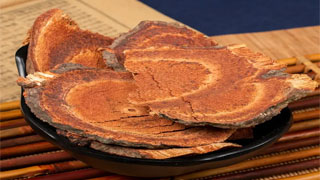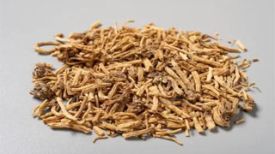
1. Aliases
Blood Dragon Vine, Nine Layer Wind, Blood Muscle Vine, Purple Stem Vine, Blood Phoenix Vine, Big Blood Vine, and Guogang Dragon.2. Plant morphology
Climbing wooden vines. The branches are cylindrical, gray green, and the old stems are flat cylindrical, gray brown in color. After cutting, there is a bright red juice flowing out, and several eccentric rings can be seen in the cross-section. Leaves alternate, nearly leathery, with longer petioles and sparsely short hairs; Leaflets 3, terminal leaflets broadly elliptical, apex short gradually pointed, base round wedge-shaped, entire, with short fine hairs between veins and axils, lateral leaflets oblique ovate, base asymmetric. The panicle grows in the leaf axil at the top of the branch, and the inflorescence axis and total flower stalk are covered with yellow short hairs. The calyx is tubular and covered with white short hairs on the outside. The sepals are 5-lipped, fleshy, and both sides are covered with light yellow short hairs; Butterfly shaped corolla yellow white, with fleshy petals, nearly circular, clawed; Wing and keel flaps with claws and ears; 10 stamens, divided into 2 groups. Style slightly curved upwards, stigma small, head shaped, ovary superior, densely covered with white short hairs. The pods are flat, knife shaped, with a furry surface and reticular patterns, and only one seed is present at the top.
3. Origin distribution
Born in forests, shrubs, or valley forests. Distributed in Fujian, Guangdong, Guangxi, Yunnan, Guizhou and other places.
4. Harvesting and processing
Harvest in autumn and winter, remove branches and leaves, slice and sun dry.
5. Characteristics of medicinal herbs
The stem is flat, plate-shaped, or cylindrical, usually cut into elliptical, rectangular, or irregular oblique sections. The cork skin is gray brown, with some visible gray white spots, and the area where the cork skin falls off appears reddish brown. The cut wood is reddish brown or brown in color, with numerous vascular pores and resin like secretions in the phloem, ranging from reddish brown to black brown in color, arranged in 3-8 eccentric semicircular rings with the wood; The medulla is tilted to one side. Hard texture. Mild in qi and astringent in taste.
6. Nature, taste, and meridian tropism
Warm in nature, bitter and sweet in taste. Return to the liver and kidney meridians.
7. Effect and function
Nourishing blood, promoting blood circulation, and unblocking collaterals. Belonging to the classification of blood activating and stasis resolving drugs, it belongs to the category of blood activating and meridian regulating drugs.
8. Clinical applications
Dosage 9-15 grams, decoct soup or soak in wine. Used to treat menstrual disorders, blood deficiency and yellowing, numbness and paralysis, and rheumatism and pain.
9. Pharmacological research
It has the effects of vasodilation, antiplatelet aggregation, and promoting phosphorus metabolism. The water decoction has a mild inhibitory effect on the hearts of both in vitro and in vivo toads; It can also increase the blood cell function of middle-aged rabbits and increase their hemoglobin levels; Can enhance the rhythmic contractions of the uterus. It has the function of regulating blood lipid and anti atherosclerosis. Using 10-20 milliliters of chicken blood vine syrup three times a day has a good therapeutic effect on treating anemia. The use of "Shengbai Chongji" or "Jijia Shengbai Tang" with chicken blood vine as the main medicine has good clinical efficacy in treating leukopenia. It can also treat rheumatoid arthritis, lupus erythematosus, thrombocytopenia, acute diarrhea, and other symptoms.
10. Chemical composition
Contains various components such as isoflavones, dihydroflavonoids, chalcone, estrogens, triterpenes, sterols, epiterpenoids, carotenoids, mangiferin, epicatechin, aloe emodin, etc.
11. Taboos for use
Those with yin deficiency and excessive fire should use it with caution.
12. Compatibility prescription
① Treatment of rheumatism and pain: 15 grams of chicken blood vine, 15 grams of half maple lotus, 15 grams of Angelica sinensis, 9 grams of Achyranthes bidentata, 15 grams of maple leaf parasitic plant, 15 grams of sea breeze vine, and 15 grams of fermented soybean ginger. Boiled in water. (Clinical Application of Traditional Chinese Medicine - Chicken Blood Vine Decoction)
② Treatment for elderly patients with vascular sclerosis and lower back neuralgia: 20g of chicken blood vine, 15g of Eucommia ulmoides, 10g of acanthopanax bark, and 15g of raw Rehmannia glutinosa. Boil 500 milliliters of water to 200 milliliters, remove residue, and take 3 portions daily. (Modern Practical Traditional Chinese Medicine)
③ Treatment for lower back pain and vaginal discharge: 30g of chicken blood vine, 15g of golden cherry root, thousand catties extract, Eucommia ulmoides vine, and dry lotus root, and 15g of Codonopsis pilosula if necessary. Take one dose daily and decoct twice. (National Compilation of Chinese Herbal Medicine)
④ Treatment of amenorrhea: 30g each of chicken blood vine and puncture stone. Boiled in water, 1 dose per day. (Selected Explanations of Chinese Herbal Medicine for Longevity)
⑤ Treatment for aplastic anemia: 60-120 grams of chicken blood vine, 2-4 eggs, and 10 red dates. Add 8 bowls of water and fry until half of the bowl is full (remove the shell of the eggs and fry again). Take eggs and medicinal juice together, one dose per day. (National Compilation of Chinese Herbal Medicine)
The content of the article is for clinical reference only. Non professionals in traditional Chinese medicine are not allowed to try medication.


